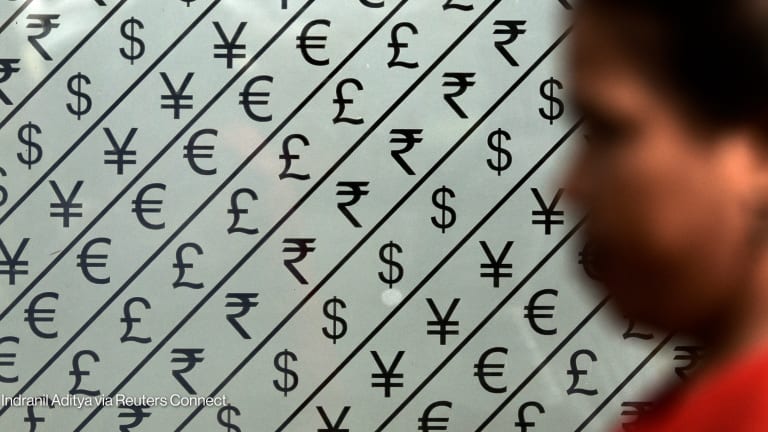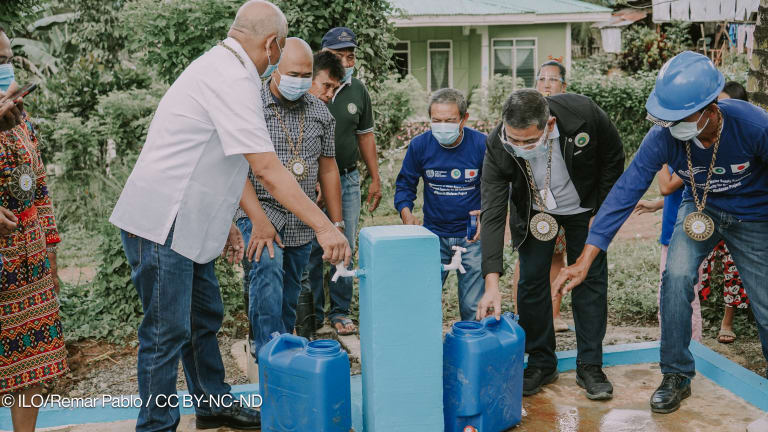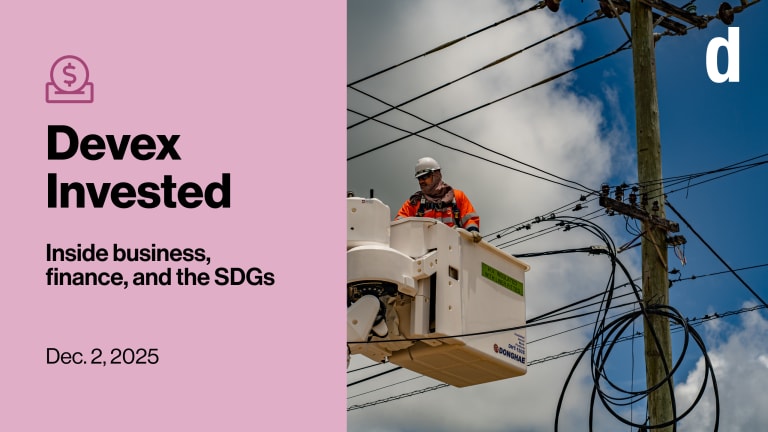
Ten days after Super Typhoon Haiyan tore into the central Philippines, government officials and analysts are starting to weigh in on the deadly storm’s impact on the country’s development outlook.
Buoyed by a resurgent economy and early successes in President Benigno Aquino III’s anti-corruption drive, the Philippines has recently been hailed as one of the region’s brightest development hot spots.
Last week, Philippine Finance Secretary Cesar Purisima said that the devastation from Haiyan could shave off as much as 1 percentage point off growth next year. Just ahead of the storm, the World Bank had raised its growth forecast for the Philippines to 7 percent in 2013 and 6.7 percent in 2014.
Nonetheless, many remain optimistic that Haiyan will be more of a hiccup rather than a major setback on the Philippines’ overall development trajectory. Affected provinces account for only 12.5 percent of the country’s gross domestic product.
According to Bart Edes, director of poverty reduction, gender and social development for the Asian Development Bank, reconstruction spending might even provide a lift to the Philippine economy next year.
“It will take time for households to get back on their feet; and for farms, fisheries, and businesses to return to production. While this will act as a drag on growth, the reconstruction efforts themselves will add to GDP,” Edes told Devex.
As reconstruction and relief money pours into the Philippines from across the international community, most analysts agree that sustained and predictable aid flows from foreign donors will also be vital to maintaining and building upon the country’s development progress. The Philippine government relies on official development assistance for roughly 5 percent of its expenditures.
Encouraged by Aquino’s commitment to reform, over the past three years, major aid donors — particularly the United States — have revitalized their relationships with the Philippines. In the wake of Haiyan, these donors will be under increasing pressure to bolster their disaster risk reduction programming in the Philippines, one of the most disaster-prone countries in the world.
Investments in disaster risk reduction must involve standalone efforts like flood control and “embedded actions,” such as “ensuring new structures are designed to withstand high winds,” Edes asserted.
Below, Devex ranks the Philippines’ leading development aid donors for 2013 and assesses their programs and priorities. Our analysis finds that ahead of Haiyan, a number of the Philippines’ top donors had already been ramping up their support for disaster risk reduction, including the United States, Japan and the ADB. While past estimates have placed China on this list, neither the Chinese nor Philippine governments have disclosed data on Beijing’s development assistance to the Philippines for this year.

Asian Development Bank ($625.6 million)
In 2011, ADB and the Aquino administration agreed on a country partnership strategy for the Philippines, historically one of the largest recipients of the bank’s financing. In line with the strategy, through 2016, ADB will prioritize lending in the following sectors: transport, energy, education, agriculture and natural resources, and water supply.
This year, ADB has programmed funding for two large-scale programs: KALAHI–CIDSS National Community-Driven Development Project ($372 million) and the Local Government Finance and Fiscal Decentralization Reform Program ($250 million). According to ADB, it is increasingly shifting its support from standalone bank projects to nationally led programs such as KALAHI–CIDSS.
While still a small share of its lending portfolio, disaster risk reduction is also fast becoming a priority for ADB’s engagement in the Philippines. Since last year, ADB has been providing preparatory technical assistance for a $70 million disaster risk financing project that the bank is also funding.
Japan ($496.5 million)
Slated for more than 60 percent of Japanese aid to the Philippines in 2013, Tokyo’s development engagement with Manila remains heavily skewed toward infrastructure. During a visit to Manila in July, Japanese Prime Minister Shinzo Abe pledged to further bolster cooperation with the Philippines on transportation infrastructure in the country’s major urban areas. The Aquino administration has tapped the Japan International Cooperation Agency to develop a transportation roadmap to help ease congestion in metropolitan Manila.
After infrastructure, however, disaster risk reduction garners the second-largest share (19 percent) of Japanese development aid to the Philippines in 2013. The Japanese government has programmed more than 2 billion yen ($20 million) for the Pinatubo Hazard Urgent Mitigation Project, its single-largest contribution to DRR in the Philippines this year.
JICA’s Philippine program has been under increased scrutiny recently, prompted by allegations that a JICA official in Manila had embezzled more than $60,000 in ODA funds through the end of last year. JICA officials have vowed to step up their oversight efforts as a result of the allegations.
World Bank ($408 million)
On Tuesday, World Bank President Jim Yong Kim told reporters in Washington the bank was considering an increase in its support for conditional cash transfers in the Philippines. The multilateral lender’s more than $500 million in financing thus far has been instrumental in the scaling up of the Philippine government’s CCT program. According to Kim, the bank is in the midst of discussions with Manila on whether to remove conditions on the cash transfers in light of the devastation from Super Typhoon Haiyan.
Conditional cash transfers have been one of the World Bank’s marquee initiatives under its 2010-2013 country assistance strategy, which focuses on macroeconomic stability, investment climate improvement, resiliency and public service delivery for the poor. The bank’s single-largest investment in the Philippines this year has been $300 million in budget support to assist the Aquino administration in its policy and institutional reforms.
Following more than a year of consultations and discussions, the World Bank plans to release a 2014-2016 country strategy for the Philippines before the end of 2013.
United States ($250.3 million)
Under Obama, the United States has elevated its development partnership with the Philippines — historically one of the top recipients of U.S. foreign aid in the region — even further. In 2010, the performance-based U.S. aid agency, the Millennium Challenge Corp., signed a five-year, $433.9 million compact with the Philippines. A year later, the Obama administration named the Philippines as one of only four participating countries in its Partnership for Growth program, which aims to address constraints to broad-based economic growth. The Philippines is also a focus country for two of the administration’s marquee aid initiatives: the Global Climate Change Initiative and the Global Health Initiative.
The U.S. Agency for International Development’s mission in Manila — which manages the vast majority of U.S. aid programming in the Philippines — has been noticeably aggressive in implementing its USAID Forward reform agenda in the country. Despite widely publicized allegations that a Philippine anti-human trafficking group had recently embezzled USAID funding, USAID Philippines has set a goal of channeling 40 percent of its funding to local partners by 2015, well above the agency-wide target of 30 percent. In September, USAID launched a $24 million grant facility for local nongovernmental organizations.
As part of the Global Climate Change Initiative, USAID Philippines has been ramping up its disaster risk reduction programming, which focuses on strengthening the capacity of regional and provincial-level DRR councils. The Philippines is one of only seven countries that receive funding in each of GCCI’s three pillars: adaptation, clean energy and sustainable landscapes.
France ($191.7 million)
With a mandate to support green and inclusive growth in the Philippines, the French Development Agency opened an office in Manila in 2010. Just three years into its development partnership with the Philippines, France has rapidly joined the ranks of the country’s major development partners. After signing a memorandum of understanding on development cooperation with the Philippine government, early last year, AFD revealed plans to extend some 100 million euros ($132 million) in loans annually over the next 12 to 20 years.
AFD has begun to disburse 150 million euros ($201 million) in co-financing to ADB’s Local Government Finance and Fiscal Decentralization Reform Program. In addition to governance, the French aid agency anticipates that the environment, transport, water and sanitation, renewable energy, and forestry sectors will receive assistance in the coming years.
Australia ($127.4 million)
In March 2012, the Australian and Philippine governments signed a statement of commitment for Canberra’s development partnership with Manila through 2017. Over that period, education is slated to remain the flagship sector for the Australian government’s aid program in the Philippines. Most notably, Canberra is currently assisting the Philippine government in its rollout of a national K to 12 program, which is, in part, modeled after schools in the Australian state of New South Wales.
Governance, economic development, and humanitarian and disaster response, including disaster risk reduction, are also priorities for Australia’s aid engagement in the Philippines. Over the next year, Canberra anticipates that its assistance to the Philippines will generate hazard risk and vulnerability maps in 14 of the country’s provinces.
Budget pressures in Canberra have, however, begun to take their toll on Australian aid spending in the Philippines. Earlier this year, the Australian government axed some of its climate change adaptation programming in the country following its diversion of aid money for domestic asylum seeker costs.
European Union ($30.9 million)
In July of last year, EU foreign affairs chief Catherine Ashton and Philippine foreign affairs secretary Albert Del Rosario signed a five-year trade and development cooperation agreement between the European Union and the Philippines — the first bilateral pact between the two parties in more than three decades. Ashton and Del Rosario pledged to “make available” the resources needed to establish and enhance cooperation on key development issues, including disaster risk management.
In line with this agreement between Brussels and Manila, some analysts say that the Philippines is unlikely to be affected by the European Commission’s proposed aid differentiation policy, which would effectively discontinue assistance to a host of other middle-income countries over the next EU financing period of 2014-2020.
The European Union had previously programmed 69 million euros ($92.9 million) in assistance to the Philippines from 2011 to 2013. The EU set aside 51 percent of that amount for health, 25 percent for governance and 17 percent for support for vulnerable populations. The EU is currently soliciting proposals for a health sector reform technical assistance project in the Philippines.
South Korea ($24.8 million)
On the backs of deep-seated ties between the two countries dating back to the Korean War, the Philippines has emerged as one of the top beneficiaries of South Korea’s fledgling yet ambitious aid program. In 2011, the Philippines was the fifth-largest recipient of official development assistance from South Korea.
According to South Korea’s 2012-16 country partnership strategy with the Philippines, over that period, 70 percent of South Korean aid to the country will be focused on three priority areas: economic infrastructure, agricultural development and health. The South Korean government has expressed interest in sharing lessons from its development experiences with the Philippines through its Knowledge Sharing Program.
Join the Devex community and gain access to more in-depth analysis, breaking news and business advice — and a host of other services — on international development, humanitarian aid and global health.








